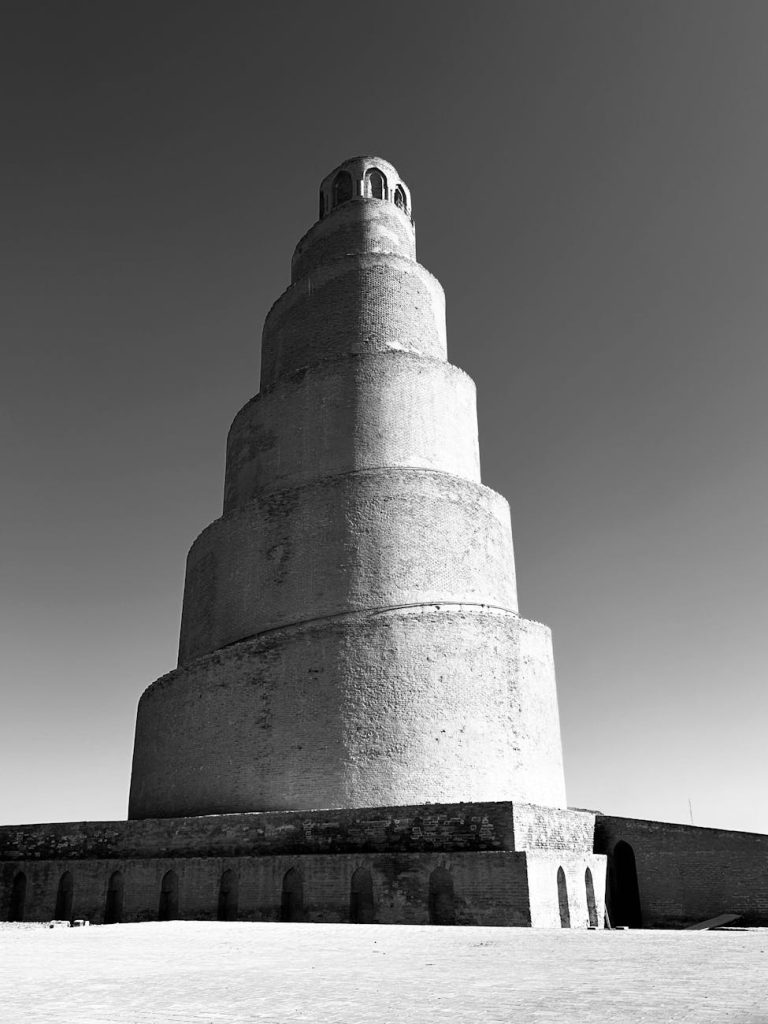
History of the Abbasid Caliphate
The Abbasid Caliphate, established in 750 CE, marked a significant turning point in Islamic history. The caliphate moved the capital from Damascus to Baghdad, igniting a golden age of culture, science, and art that greatly influenced the Islamic world and beyond. Under Abbasid rule, Iraq became a hub for intellectual and artistic activity known as the “House of Wisdom,” fostering advancements in various fields.
The construction of impressive structures was pivotal during this period, showcasing the wealth and architectural innovation that characterized the Abbasid era. One of the most prominent examples of this remarkable architectural heritage is the Great Mosque of Samarra.
Spiral Minaret Highlight
The most distinguishing feature of the Samarra Great Mosque is its unique spiral minaret, known as the Malwiya Minaret. Standing at an impressive 52 meters (about 170 feet), this minaret is one of the tallest in the world and serves as a remarkable demonstration of Islamic architectural ingenuity.
The spiral design allows for a gradual ascent, which was both practical for the muezzin who called the faithful to prayer and serves an aesthetic purpose, drawing the eye upwards in a celebration of faith and divine connection. The minaret is constructed from baked brick, designed to withstand the harsh climate of Iraq and retain its structural integrity over centuries. Its architectural style has influenced subsequent mosque designs across the region and beyond, symbolizing the apex of Abbasid architectural prowess.
Architectural Features
The Great Mosque of Samarra is also renowned for its vast size and intricate architectural details. Covering an expansive area of approximately 156 hectares (386 acres), it featured a large central prayer hall and a series of courtyards. The mosque integrated diverse elements of previous architectural styles and effectively brought together various aesthetic influences, marking a blend of landscape and spirituality.
Key architectural elements include:
- Brickwork: The mosque’s construction predominantly features brick, demonstrating both the availability of materials and the sophisticated brick-making techniques of the time.
- Arches and Domes: The mosque comprises beautifully designed arches and domes that harmonize with the overall layout, showcasing a blend of functionality and decoration typical of Abbasid architecture.
- Decorative Details: While much of the original intricate ornamentation has been lost or damaged over time, details that remain reflect the high artistic standards of the period.
These features not only highlight the architectural ambition of the Abbasid Caliphate but also represent a fusion of religious and cultural practices unique to that era.
Cultural Importance
Samarra’s Great Mosque holds immense cultural significance as a symbol of the Islamic Golden Age. It exemplifies the theological and communal aspects of Islamic worship while reflecting the socio-political climate of the Abbasid period. The mosque was once a center for education and debate, drawing scholars and leaders from across the Islamic world to engage in discussions that shaped the course of Islamic thought and jurisprudence.
Moreover, the mosque’s architecture has inspired various cultural expressions and artistic endeavors, reinforcing the mosque’s status as an icon of Islamic heritage. Today, the Great Mosque of Samarra is recognized as a UNESCO World Heritage site, emphasizing its importance in the global cultural landscape and the necessity of its preservation [1].
Visiting Guidance
For those looking to explore the Great Mosque of Samarra, proper planning enhances the experience:
- Access: Visitors should check local travel advisories and regulations, as access can vary due to geopolitical conditions.
- Best Time to Visit: The best time to visit is during the cooler months, from October to March, avoiding the intense heat of summer.
- Guided Tours: It is advisable to engage in guided tours to delve deeper into the history and nuances of the site. Local guides offer valuable insights, enriching the overall visit.
- Respectful Conduct: As with any religious site, respectful behavior and attire are encouraged to honor the local customs and practices.
For additional details on transportation and amenities, resources like Lonely Planet provide updated information [2].
Conclusion
The Great Mosque of Samarra stands not just as an architectural marvel of the Abbasid Caliphate but as a testament to the enduring legacy of Islamic culture and innovation. Its iconic spiral minaret and expansive layout continue to captivate visitors and scholars alike, serving as a reminder of the rich history that shaped Iraq and the Islamic world. As a UNESCO World Heritage site, it invites exploration and appreciation, ensuring that the legacy of the Abbasid Caliphate endures for generations to come.
References
Get epic product battles straight to you! 🥊 📦 ![]()
